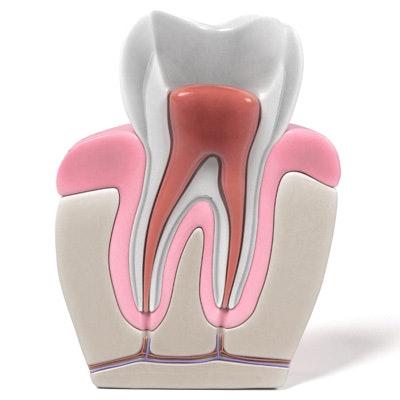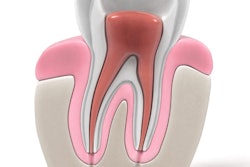
A single session of endodontic treatment on primary teeth can reduce the prevalence of harmful bacteria in root canals, a new study has found. Previous research has shown that single-visit treatments can effectively reduce bacterial counts for adults, but this is one of the first studies to investigate the topic in children.
The researchers took bacterial swabs before and after root canal treatment on primary teeth to see whether a single-session protocol (SSP) significantly lowered eight types of bacteria associated with failed endodontic treatment. They published their findings in European Archives of Paediatric Dentistry (January 24, 2018).
"The SSP used can significantly reduce the septic content in root canals of primary teeth with pulp necrosis and periradicular lesion," wrote the authors, led by T. C. Triches, DDS, MD, PhD, from the Federal University of Santa Catarina Department of Dentistry in Santa Catarina, Brazil.
Reduction of harmful bacteria
The scientific literature is sorely lacking studies that investigate the efficacy of various endodontic treatments in primary teeth, the authors noted. Therefore, they decided to investigate how effectively single-session treatment can reduce harmful bacteria in the root canals of primary teeth.
The study included five children who needed treatment on a total of 16 root canals caused by advanced caries, periradicular lesions, abscesses, or pulp necroses. The patients were otherwise healthy and had not used an antibiotic or antimicrobial within the past three months.
The researchers performed a single-session root canal treatment on each patient by emptying and cleaning the canals, irrigating with three disinfectants and antiseptics, and then filling the canals. They took two bacterial samples during the process: first after the tooth was opened (T1) and again after the irrigation (T2).
The single-session protocol “can significantly reduce the septic content in root canals of primary teeth with pulp necrosis and periradicular lesion.”
The researchers then analyzed the change in the number and prevalence of eight bacteria species that have been associated with failed endodontic treatment in permanent teeth:
- Enterococcus faecalis
- Parvimonas micra
- Porphyromonas endodontalis
- Porphyromonas gingivalis
- Prevotella intermedia
- Prevotella nigrescens
- Tannerella forsythia
- Treponema denticola

Single-session treatment significantly reduced the number and proportion of P. gingivalis and T. forsythia bacteria species. Treatment also reduced the counts of the other six species but not to a significant amount.
The researchers attributed the reduction in the number of bacteria to the three antiseptic and disinfectant agents they used, which alter the environment of the cavity.
"Statistically significant reductions between T1 and T2 were found in the count and mean number of general bacteria, as well as specialties associated with unsuccessful endodontic treatment, demonstrating the effectiveness of SSP," the authors wrote. "Therefore, chemomechanical preparation (medications combined with active mechanical manipulation) helped to reduce the concentration of the infection, with exposure and removal of bacteria that occasionally remain in the dentinal tubules."
More research to come
The 16 teeth included in the study met the requirements for minimum sample size needed; however, more teeth might have provided a better indicator for the effectiveness of single-session treatment, according to the authors. Furthermore, additional bacteria may have existed in the canals but were not concentrated enough at the time of sampling to be detected by the researchers.
The study showed that single-session root canal treatment can reduce the number of several types of bacteria associated with failed endodontic treatment, but the authors aren't done with their research yet. They plan to continue monitoring the five patients from the study to assess the short- and long-term outcomes of the treatment.
"It is important to determine whether the bacteria analyzed herein will lead to unsuccessful outcomes of the endodontic therapy," they wrote. "Therefore, this research group is carrying out periodic clinical and radiographic evaluations of all cases treated in the study using the SSP."



















